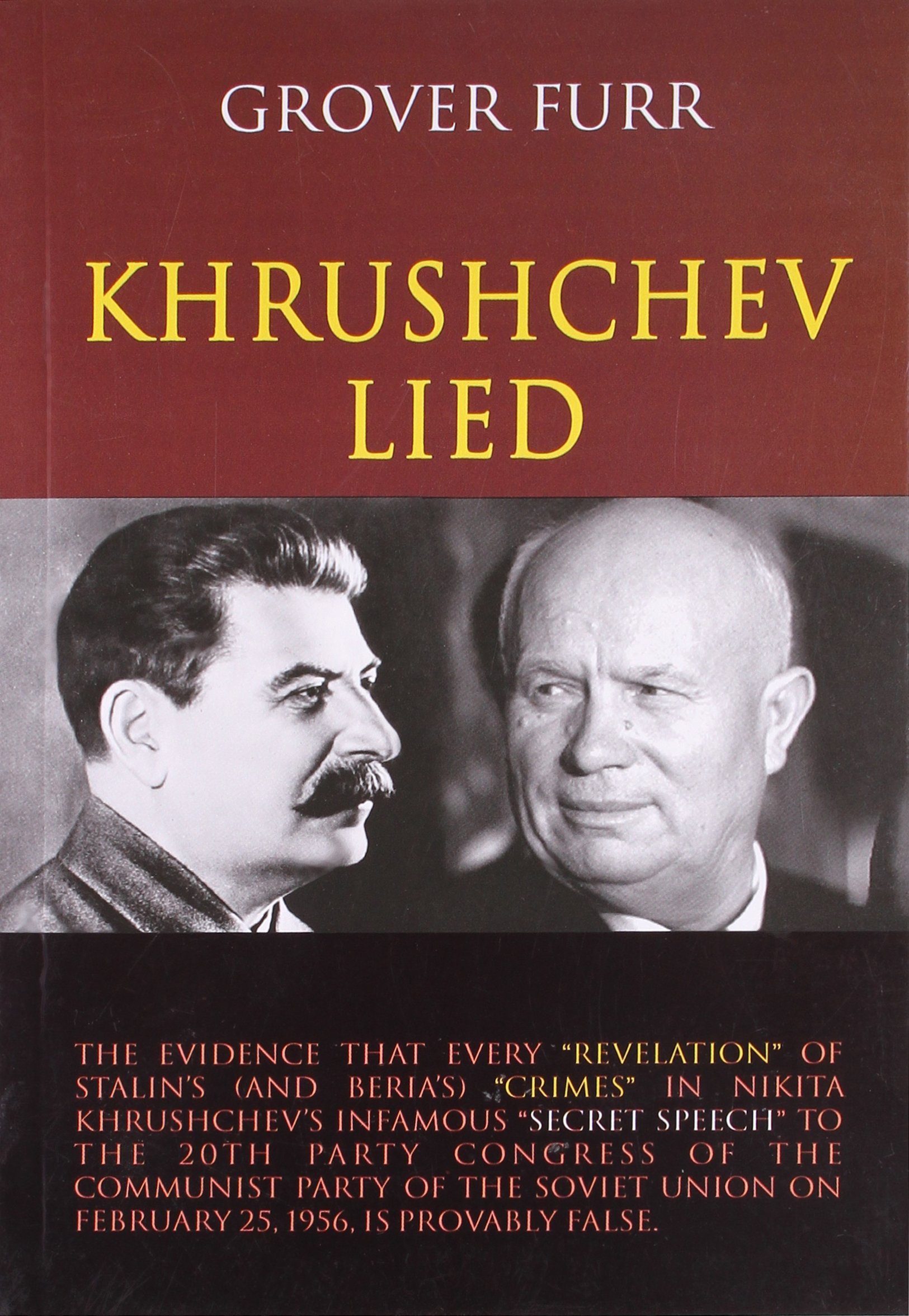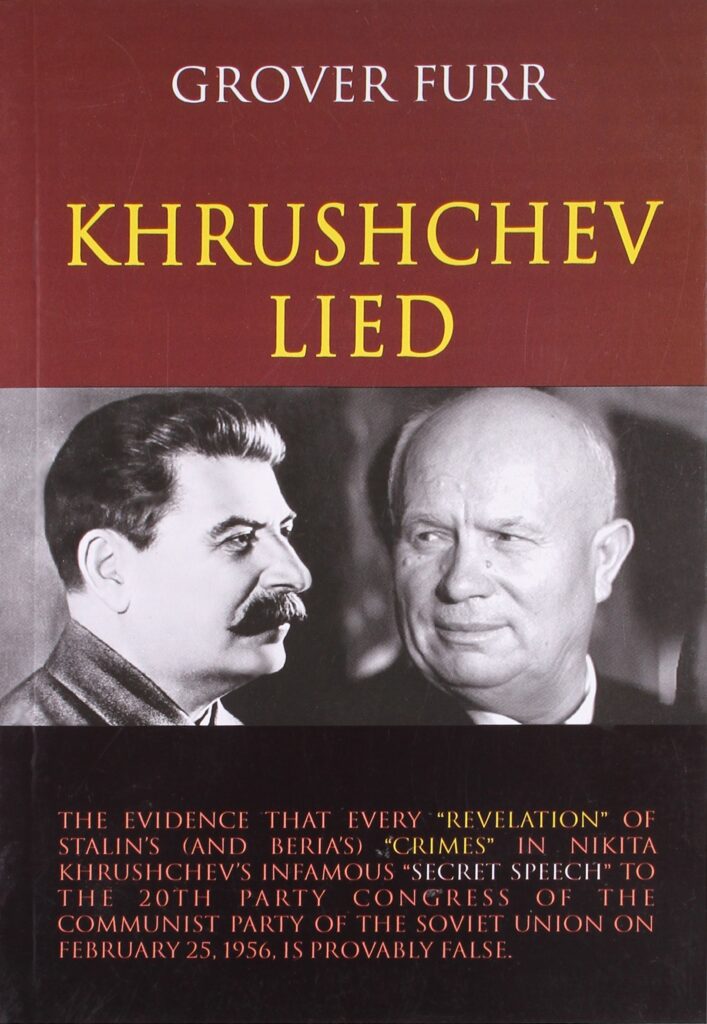
Jean-Jacques Marie
Grover Furr, Khrushchev Lied. The Evidence that Every Revelation of Stalin’s (and Beria’s) Crimes in Nikita Khrushchev’s Infamous Secret Speech to the 20th Party Congress of the Communist Party of the Soviet Union on February 25, 1956, is Provably False(Kettering, OH: Erythos Press, 2011).
On 25 February 1956, the First Secretary of the CPSU delivered a report to a closed session of the party’s 20th Congress denouncing a certain number of Stalin’s crimes. Although this report was declared ‘secret’, it was read to some 25 million members of the CPSU and the Komsomol (Communist youth), as well as to suitable ‘non-party’ persons. Published in the United States and internationally at the beginning of June, it provoked a brutal shock in Communist parties across the world. An obscure American academic, Grover Furr, now reveals – with a quite unintended humour – that Khrushchev invented everything about Stalin’s crimes, which are thus reduced to the rank of fairy tales.
Furr’s book, originally published in 2010 in Russia under the title Shadows of the 20th Congress, or Anti-Stalin Villainy, offers unsuspected pleasures. Furr’s sensational discovery presents him – again quite unwittingly – as a disciple of Alfred Jarry: Khrushchev was an old secret enemy of Stalin, a member of the fantastical conspiracy of Trotskyists and rightists fabricated by Stalin, a nostalgic supporter of Bukharin, shot in March 1938. Furr denounces Khrushchev’s secret report as a ‘complete deception’ and claims: ‘Not a single statement of Khrushchev’s “revelations” about Stalin or Beria has proved accurate’ (p. 10). He asserts, without joking: ‘All the indications we currently have [???] tend to show the existence of a series of anti-government Trotskyist-rightist plots involving many senior party leaders, the NKVD heads Yagoda and Yezhov, high-ranking military chiefs and many others’ (who despite being in decisive positions at the head of the police, the army and whole regions of the Communist party, never tried anything, which proves that some conspirators are nicely complacent). ‘There is much circumstantial proof [proof as soft as Dali’s famous watches – JJM] that Khrushchev himself may [sic!] have participated in this Trotskyist-rightist conspiracy…) The hypothesis [re-sic!] that Khrushchev may [re-re-sic!] have been a member of a secret branch [which therefore left no trace!] of the highly ramified Trotskyist-rightist conspiracy is reinforced by the fact that he was certainly [re-re-re-sic!] involved in a number of other plots’ (pp. 34-5 and 220)
Thus, Khrushchev’s unknown, but supposedly ‘certain’ presence in plots of which nothing is known would confirm the hypothesis of his participation, ‘secret’ and thus unknown to anyone, in one of the many indistinct ‘branches’ of other possible imaginary plots.
Superb reasoning: one adventurous hypothesis confirms another hypothesis which is even more so. And, yes the moon is made out of blue cheese and Khrushchev is a liar. This Stalinist logorrhoea extends over more than 400 pages, in the course of which, for example, Furr takes at face value the confessions extorted from the defendants in the Moscow trials and even from the leader of the NKVD from 1936 to 1938, Nikolai Yezhov, after he had been dismissed and arrested. And, with totally unwitting humour, Furr asserts that Yezhov organised the ‘massive atrocities’ which he was guilty of for two years ‘to cover up his own involvement in the rightist conspiracy and military espionage for the benefit of Germany as well as in a plot to assassinate Stalin or [sic!] another member of the Politburo and seize power in a coup d’état’ (p. 65). Now, it was this same Yezhov who organised the second and third Moscow trials that so delight Furr. But, if the aim of his massive atrocities was to cover up his own involvement in the ‘rightist conspiracy’ (???), then the confessions he extorted supposedly served this cover-up… in other words, the confessions Furr takes at face value were a manoeuvre of the conspirator… The load a Stalinophile has to bear is decidedly a heavy one.
Khrushchev, Trotsky, same fight?
Worse still, according to Furr, Khrushchev’s ‘denunciation of Stalin in the “secret report” essentially echoes Trotsky’s earlier demonisation of Stalin… The Khrushchev report revived Trotsky’s caricature of Stalin… the “secret report” constituted an unacknowledged rehabilitation of Trotsky’ (p. 235). Now, Furr swears that ‘Trotsky was involved with other oppositions in the USSR to overthrow Stalin’s government and even had contacts with the German and Japanese military. There is also evidence that Trotsky’s clandestine groups both outside and inside the party were involved in sabotage and espionage in the USSR and in spreading false accusations of treason against others.’ And he adds: ‘There is much documentary evidence that Trotsky and his supporters were involved in anti-Soviet plots, including with the Nazis’ (p. 40). The Stalinist dinosaurs, unlike the herbivores of yesteryear, are clearly not all extinct.
Oh, what a lovely deportation!
Furr also considers the mass deportation of the peoples of the Caucasus by Stalin in 1943-4 to have been very humane. He says: ‘Splitting up a small national group united by a language, a unique history and a culture in fact amounts to destroying it. In the case of the Chechens, Ingush and Crimean Tatars, collaboration with the Nazis was massive, involving the largest part of the population. Trying to isolate and punish “only the guilty” would have led to dividing the nation and probably destroying it entirely. Instead, the national group was maintained and its population increased… the Nazi collaboration of these groups was so massive that punishing those involved would have endangered the survival of these groups. They would have had to be deprived of young men by imprisonment and execution, leaving very few young men for young women to marry. Deportation kept these groups intact. The deportations took place almost entirely without victims’ (almost… since no one is perfect, even Stalin! yet on average a quarter of the deportees died in the course of a transport that took several weeks). ‘Thus their cultures, their language and indeed their existence as peoples were safeguarded’. Not deporting them, Grover Furr concludes, ‘would have led to… the destruction of these ethnic groups as ‘peoples’ – in short, to genocide’ (pp. 111-12).
He maintains what we dare not call the same ‘reasoning’ about the Crimean Tatars. Claiming that their ‘massive collaboration’ had been established and that 20,000 Tatars had deserted from the Red Army, he asserts: ‘The Soviets could have killed the 20,000 deserters. Or they could have imprisoned and deported only those young men of fighting age. That would have meant the virtual end of the Tatar nation of Crimea, as there would have been no husbands for the next generation of young women. Instead, the Soviet government decided to expel the whole nationality to Central Asia, which was done in 1944, giving them land and a few years of tax relief. The Tatar nation remained intact’ (p. 113) – except for the thousands of deaths during the transport which took more than a month, but why get lost in such trivial details? He forgets, alas, to evoke the fate of the Volga Germans – deported as collaborators even before the Wehrmacht entered their territory: real deportation as a response to virtual collaboration… It is by dialectic of this kind that we recognise a real leader!
Furr’s little book has the same relationship to history as Alfred Jarry’s The Passion Considered as an Uphill Bicycle Race, save for one nuance: the exhilarating aspect of the creator of King Ubu is totally absent from his logorrhoea.
Losurdo and the beauties of the gulag…
Furr’s book comes with a preface by the Italian academic Domenico Losurdo, a specialist on Hegel. Losurdo has acquired modest fame by assuming the defence of Stalin in a book subtitled ‘History and Criticism of a Black Legend’. According to him, the gulag was, among other things, ‘a pedagogical concern’. Losurdo waxes lyrical on the prisoners’ contribution to the building of socialism: ‘the gulag prisoner was a potential “comrade” obliged to participate in particularly harsh conditions in the productive effort of the whole country’. Particularly harsh, of course, but the word ‘comrade’, even very potential, is priceless! And Losurdo is even more ecstatic about the exquisite politeness that governed relations between guards and prisoners: ‘until 1937 the guards called the prisoners “comrade”’. So, a guard that shot a prisoner who clumsily stepped too far outside the column actually shot a comrade – sadly, of course, thus giving him advance consolation. Losurdo adds: ‘And besides, imprisonment in concentration camp did not exclude the possibility of social advancement’ (Staline, histoire et critique d’une légende noire, pp. 30, 57 and 215)’. The gulag as a school of courtesy and on-the-job training – a real social elevator, a true lost paradise!
The rescuing deportation of the peoples of the Caucasus and the building of such a fraternal gulag confirm what his sycophants of yesteryear proclaimed: Stalin was indeed the greatest humanist of our time.
Translated by David Fernbach
[1] [Page references here are to the French edition of the book.]

